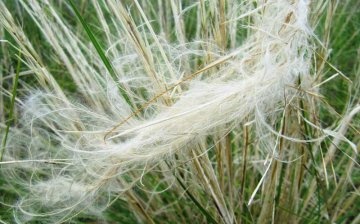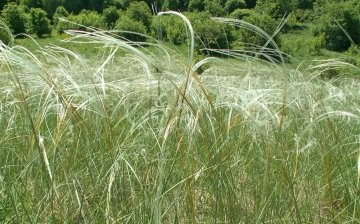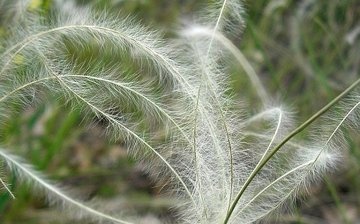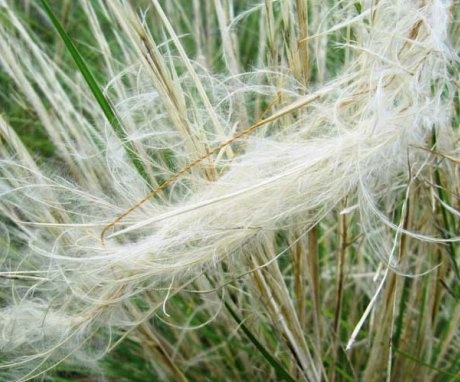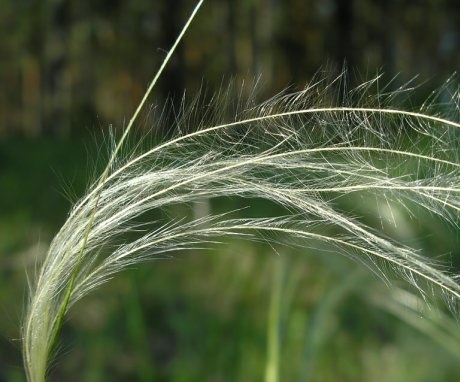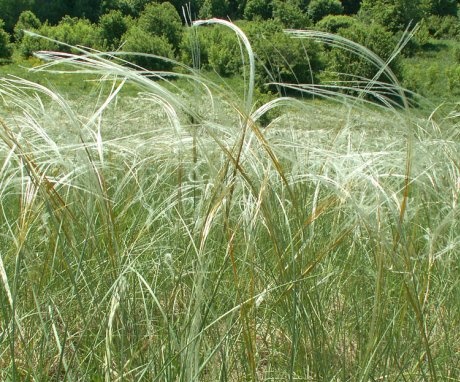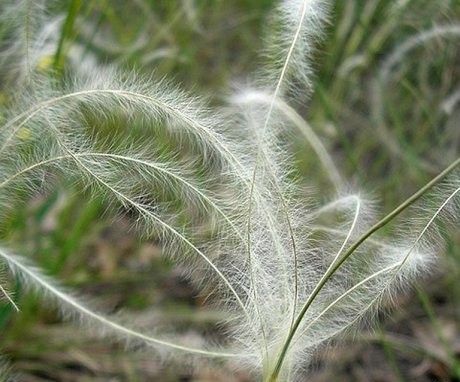Beautiful feather grass: description and agricultural technology
Feather grass is a rare plant. This is a perennial herb of the Bluegrass family (cereals), which grows in the wild in southern Europe, the Caucasus, and Central Asia. In total, about three hundred species are known, in our region there are about 80 of them.
Content:
- Feather grass species
- Feather grass is beautiful: description
- Reproduction and planting
- Using the beautiful feather grass
Feather grass species
Feather grass is a perennial herb that grows in the steppes. The beautiful feather grass blooms for about a month, starting from the end of May. Prefers to grow in well-lit areas. Drought tolerant. The feather grass root, unlike many cereals, does not form creeping shoots. Feather grass differs from other cereals in that its grain is located in the lower scales with a sharp top. The bristles on the axis are directed in the direction opposite to the spine, which is twisted in the form of a spiral.
Feather grass types:
- Feathery is often grown in gardens and is widely used in garden decoration. It has smooth leaves that end in a tuft of hairs. The awns are long, reaching 40 cm.
- The hairy worm differs in color and shape of the leaves. They have a grayish tint. Each leaf is folded into a tube. Awns are fleecy, rather short, up to 18 cm. Hairy feather grass grows up to 80 cm in height.
- The pubescent feather grass in the wild grows not only in the steppe, but also on the rocks. The stem under each node is covered with an edge. Leaves are twisted into a tube up to 2 mm in diameter. They are covered with fine soft bristles. The length of the awn is up to 41 cm.
- Far Eastern grows in Siberia, Japan, China. Plant height 180 cm. This is the tallest type of feather grass. Its leaves are wide, shiny, up to 3 cm wide. The awns are long, up to half a meter.
- The thinnest is grown as an annual plant because it can withstand temperatures between 15 and 25 degrees. Originally from Mexico. Feather grass leaves of this variety are tough, whitish spikelets. Height up to 80 cm.
- The most beautiful one reaches a height of 40-80 cm.
Feather grass is beautiful: description
Feather grass of this species is called the most beautiful for a reason. During flowering, it amazes with its iridescent strands. The most beautiful feather grass is distinguished by pubescent spikelets. During flowering, several silky filaments emerge from the panicle. They wander down smoothly, making the plant look like a pillow.
If there is a flowering plant nearby, it seems that it is shrouded in a cloud of smoke.
Features of the structure:
- Feather grass is the most beautiful - a turf plant with a large number of stems. They are smooth, erect. Sometimes pubescent under the knots.
- Basal leaves are dark green, narrow, long, straight. Top not pubescent.
- Stem leaves are short, most often folded in length, sometimes flat, up to 60 cm long, covered with small thorns and fine hairs.
- The inflorescences of the most beautiful feather grass are racemose panicles. They look compact, compressed. The length of the awn is up to 30 cm, the hairs of the edge reach 3 mm.
The growth zone of the most beautiful feather grass is the rocky areas of southern Europe (Crimea), Western Siberia, Central Asia, the Caucasus. He is able to climb to the upper belt in the mountains. Withstands frosts down to -23 ° С.
It belongs to the Vulnerable category, because the number of beautiful feather grass is decreasing due to intensive economic use. This is the construction of various plants and pipelines, planting of pines and other conifers.In the mountains, the steppe areas are covered by forest, which also leads to a decrease in the feather grass population. The plant is included in the Red Book of the Russian Federation. Not included in the IUCN Red List.
Reproduction and planting
To grow the most beautiful feather grass, you need to have seed. Feather grass breeds seedslike any cereals. In the wild, the wind carries grain long distances from the parent plant. This is facilitated by the pinnately pubescent networks in which it is hidden. They are picked up by the wind and carried for several meters. They hit the ground after a certain time after they land. After all, there are a lot of old grass and leaves around.
At night, under the influence of the evening dew, the spiral-shaped knee swells, unfolds, and part of the awn is pressed to the ground. At the same time, the grain is screwed into the soil. In the morning, the knee twists, the stem unbends, but the weevil cannot rise up. She is not allowed to do this by the bristles, which cling to the soil, like an arrow. It remains in the soil where it will germinate over time.
For home cultivation, seed propagation is used.
The most beautiful feather grass does not reproduce by self-seeding. Its seeds will not germinate near the mother plant. Doesn't like a transplant. It takes root after it very badly. In one place it can grow up to 10 years.
Growing features:
- Sprout seeds 1-2 months. After the sprouts appear, they are immediately planted in a permanent place. Planting time is mid-May-late June.
- You can sow seeds in the ground before winter. But in severe frosts, they may not rise.
- Feather grass is sown in the driest area, where there is never any flooding by groundwater. If there is no such site on the territory, you can arrange drainage and create a high ridge.
- The beautiful feather grass prefers gypsum or calcareous soil. Therefore, when sowing, a little lime must be added to ordinary garden soil. Humus and sand are introduced.
- It is only necessary to moisten the soil into which the feather grass is sown at the beginning, until it germinates. Then grown without watering. Excess moisture is harmful to feather grass. It reacts especially badly to stagnant moisture near the roots. In this case, he dies.
Care consists in weeding weedsthat can drown out a young plant. Later, when it grows, the weeds are not afraid of it. Sometimes mulch the soil around the plant. This is done rather so that the weeds do not break out. Feeding the beautiful feather grass is not necessary. This can only be shown if the plant is damaged by pests. In late autumn, the faded shoots are cut off, leaving leaves.
Using the beautiful feather grass
The most beautiful feather grass is grown in the garden in mixborders or flower arrangements:
- You can combine it with other cereals: foxtail, abouteverybody or miscanthus.
- The beautiful feather grass looks good in combination with poppies, sage, hyssop, echinacea, chamomile, decorative bow.
- In modern gardens, feather grass is used together with roses, climbing and small-flowered.
- Its silvery threads look beautiful until late autumn. The beautiful feather grass adorns the rock gardens. It is planted near the Thunberg barberry, next to the sod, dwarf conifers.
The beautiful feather grass is used to create dry bouquets. It does not lose its attractiveness throughout the fall and winter. Not everyone will decide to put them in the house because of the bad beliefs associated with this plant. Installed in office premises, they look original and beautiful.
The feather grass contains valuable biologically active substances. Trigdoquinine is considered one of the most valuable. Feather grass is especially rich in it. In small amounts, these substances soothe and relieve pain.
More information can be found in the video:




